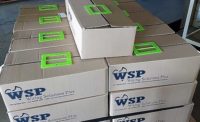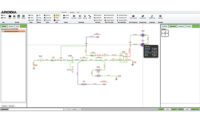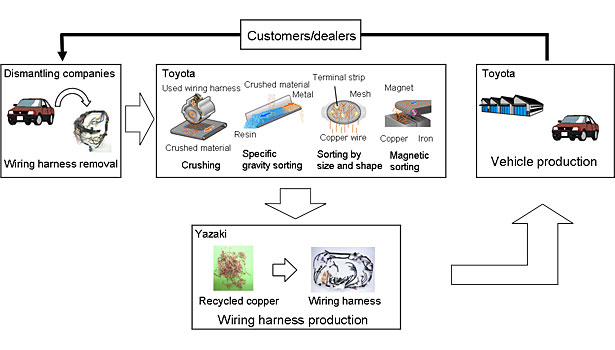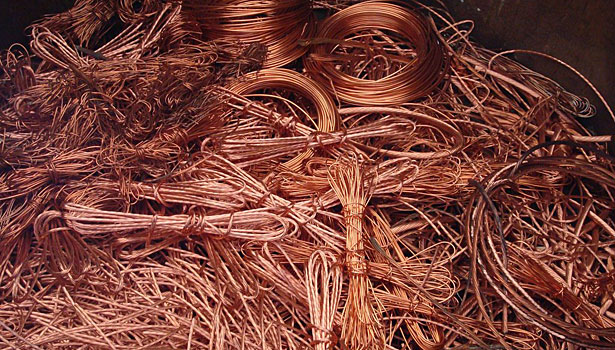Wire Harness Recycling
Toyota has developed a new technology for recycling the copper contained automotive harnesses.

Recycling automotive wiring harnesses has traditionally been difficult. There is simply too much other “stuff” bundled in with the copper. Photo courtesy Toyota Motor Corp.

The typical U.S.-built car contains more than 50 pounds of copper. Photo courtesy Toyota Motor Corp.

Toyota’s new recycling process begins by crushing and shredding the harness. The crushed material is then sent to a specific gravity sorting system, which separates resins from metals. Next, the metal particulates pass through a mesh strainer to separate out terminals and other metal parts. Finally, the remaining metal particulates pass through a magnetic screening system, which removes any ferrous particles. Photo courtesy Toyota Motor Corp.

Post-consumer material, such as old wiring, typically accounts for 39 percent to 46 percent of recycled copper, but that percentage is expected to grow rapidly in the near future. Photo courtesy TKO Recycling

No. 1 grade copper wires contain no metallic contaminants and are the most valued for recycling. Photo courtesy TKO Recycling





By some estimates, approximately 40 years’ worth of mineable copper resources remains worldwide. At the same time, global consumption is growing, driven particularly by infrastructure-related demand for wiring in emerging markets. In addition, large amounts of copper are being used for wiring and motors in hybrid vehicles, which are becoming increasingly popular.
Those trends are great news for recyclers. Indeed, thanks to recycling, the United States has been able to remain largely self-sufficient in its consumption of copper. In 1996, the United States consumed 3.8 million short tons of copper. Of that, 1.7 million short tons—44 percent—came from domestic scrap. In fact, over the past 20 years, scrap copper has provided 44 percent to 55 percent of all the copper consumed in the United States annually.
As a result, the value of copper scrap has remained high. The highest grades of copper scrap are now worth more than 90 percent of the market price for new refined copper.
The largest category of scrap is “new” scrap—in other words, the waste produced by manufacturers of wire, pipe, bus bars, contacts and other copper products. This material is directly remelted.
The other category of scrap is post-consumer material: discarded electric cable, automobile radiators, home air conditioners and other products. The extent to which this material is reused fluctuates, depending on copper prices and other considerations. In recent years, “old” scrap has accounted for 39 percent to 46 percent of the recycling stream.
Copper and Cars
End-of-life vehicles represent a gold mine—so to speak—for copper recyclers. According to the American Resources Policy Network, the typical U.S.-built car contains more than 50 pounds of copper: approximately 40 pounds for electrical components and 10 pounds for nonelectrical components. Today’s luxury cars contain some 1,500 copper wires—totaling about 1 mile in length. To put that into perspective, in 1948, the average family car contained only about 55 wires, amounting to total length of 150 feet.
The Toyota Prius contains 64 pounds of copper. While the hybrid’s batteries are nickel-based, the Prius still needs lots of copper wiring and electronics to keep it running. Future generations of hybrid and electric cars could contain even more copper.
Unfortunately, recycling this wire has traditionally been difficult. There is simply too much other “stuff” bundled in with the copper besides the obvious insulation, including connectors, terminals, solder, seals, fuses, relays, heat shields, clamps and tape.
One way or another, all that extraneous material must be removed before the copper in automotive wiring can be recycled. That’s important, because trace impurities in recycled copper can negatively affect its properties. (Some applications, such as high-conductivity wire, require newly mined copper or high-purity scrap copper that has been double-refined.)
Now, Toyota Motor Corp., has introduced a new technology for recycling the copper contained in automotive wiring harnesses. The process was jointly developed Toyota Tsusho Corp. (the trading arm of Toyota Motor), Yazaki Corp. (which makes wiring harnesses for Toyota Motor), and several Japanese vehicle dismantling companies.
After plastic shields and connectors are removed, the harness is crushed and shredded. The crushed material is then sent to a specific gravity sorting system, which separates resins from metals. Next, the metal particulates pass through a mesh strainer to separate out terminals and other metal parts. Finally, the remaining metal particulates pass through a magnetic screening system, which removes any ferrous particles.
Trial production involving small amounts of recycled copper began at Toyota’s Honsha Plant in 2013. The recycled copper is sent to Toyota’s foundries to produce reinforcing material in aluminum castings. It’s also sent to Yazaki, which turns it into new wiring for Toyota vehicles.
Stable production involving recycled copper has been achieved, and the process now produces copper with a purity of 99.96 percent. Toyota anticipates that annual production of recycled copper using this method will increase to approximately 1,000 tons in 2016.
The process was Toyota’s first collaboration with parts makers and dismantling companies in Japan on next-generation recycling systems. In the future, Toyota also plans to create another next-generation recycling project with parts makers and dismantling companies with the aim of fostering a recycling-based society.
ASSEMBLY ONLINE
For more information on wire processing and recycling, visit
www.assemblymag.com to read these articles:
Looking for a reprint of this article?
From high-res PDFs to custom plaques, order your copy today!











